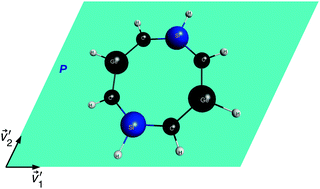From six to eight Π-electron bare rings of group-XIV elements and beyond: can planarity be deciphered from the “quasi-molecules” they embed?†
Abstract
Ab initio molecular orbital theory is used to study the structures of six and eight π-electron bare rings of group-XIV elements, and even larger [n]annulenes up to C18H18, including some of their mono-, di-, tri-, and tetra-anions. While some of the above rings are planar, others are nonplanar. A much spotlighted case is cyclo-octatetraene (C8H8), which is predicted to be nonplanar together with its heavier group-XIV analogues Si8H8 and Ge8H8, with the solely planar members of its family having the stoichiometric formulas C4Si4H8 and C4Ge4H8. A similar situation arises with the six π-electron bare rings, where benzene and substituted ones up to C3Si3H6 or so are planar, while others are not. However, the explanations encountered in the literature find support in ab initio calculations for such species, often rationalized from distinct calculated features. Using second-order Møller–Plesset perturbation theory and, when affordable (particularly tetratomics, which may allow even higher levels), the coupled-cluster method including single, double, and perturbative triple excitations, a common rationale is suggested based on a novel concept of quasi-molecules or the (3+4)-atom partition scheme. Any criticism of tautology is therefore avoided. The same analysis has also been successfully applied to even larger [n]annulenes, to their mixed family members involving silicon and germanium atoms, and to the C18 carbon ring. Furthermore, it has been extended to annulene anions to check the criteria of the popular Hückel rule for planarity and aromaticity. Exploratory work on cycloarenes is also reported. Besides a partial study of the involved potential energy surfaces, equilibrium geometries and harmonic vibrational frequencies have been calculated anew, for both the parent and the actual prototypes of the quasi-molecules.



 Please wait while we load your content...
Please wait while we load your content...